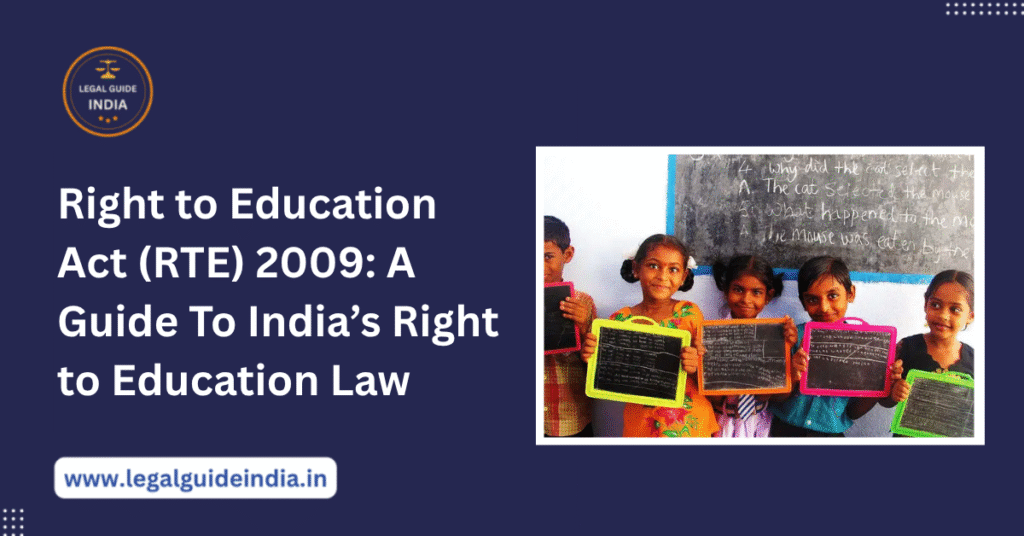The Right to Education Act, 2009, stands as one of India’s most significant legal reforms in the education sector. With the implementation of the RTE Act, India recognized education as a fundamental right for children aged 6 to 14. This landmark law has since shaped the way millions access basic education, particularly children from underprivileged communities.
Understanding the Right to Education
The Right to Education is the legal guarantee that every child in India has the right to free and compulsory education. As per Article 21A of the Indian Constitution, added by the 86th Amendment in 2002, the government must ensure that all children in the age group of 6 to 14 receive quality elementary education.
Background and History
The idea of making education a fundamental right dates back to the framing of the Constitution. Article 45, part of the Directive Principles of State Policy, had originally stated that the State shall endeavor to provide free and compulsory education for all children until they complete the age of 14 years. However, it wasn’t until 2009 that Parliament enacted a specific law to enforce this directive. The RTE Act came into effect on April 1, 2010, making India one of the few countries in the world with such a law.
Key Provisions of the RTE Act 2009
- Free and Compulsory Education: Every child aged 6 to 14 has the right to free education in a neighborhood school.
- 25% Reservation in Private Schools: All private schools (except minority institutions) must reserve 25% of seats for children from economically weaker sections.
- No Capitation Fee and Screening: Schools cannot charge any admission fees or conduct interviews for admissions.
- Standard Norms and Infrastructure: Schools must meet prescribed infrastructure norms such as the teacher-student ratio, toilets, classrooms, and drinking water.
- No Detention Policy: No child can be held back or expelled from school until the completion of elementary education.
Implementation and Role of Stakeholders
The implementation of the Right to Education Act is a joint responsibility of the Central and State governments. Schools are required to follow specific standards, while teachers must be professionally trained. Parents and guardians are encouraged to ensure their children attend school regularly. School Management Committees (SMCs) have been created to monitor school functioning and implementation of the Act.
Impact on Indian Society
The RTE Act has had a wide-ranging impact:
- Increased Enrollment: Enrollment rates at the elementary level have seen a significant increase, especially among marginalized communities.
- Girls’ Education: More girls have joined schools due to improved infrastructure, including separate toilets.
- Inclusion: The 25% reservation in private schools has helped bridge the gap between socio-economic classes.
Challenges and Criticism
Despite its success, the RTE Act faces several challenges:
- Poor Learning Outcomes: Although enrollment has increased, learning levels in reading and arithmetic remain low.
- Infrastructure Gaps: Many schools still do not meet the minimum infrastructure requirements.
- Teacher Shortage: There is a shortage of trained teachers, especially in rural areas.
- Implementation Hurdles: Bureaucratic delays and lack of awareness often hinder the effective implementation of the Act.
RTE and Education Quality
While the Act ensures access to education, its effect on quality has been mixed. Continuous and Comprehensive Evaluation (CCE) introduced under RTE aimed to assess children without pressure, but inconsistent execution has diluted its effectiveness. Ensuring quality education remains an area that needs sustained policy attention.
Achievements and Way Forward
Since its implementation, the Right to Education Act has enabled millions of children to step into classrooms. States like Rajasthan, Tamil Nadu, and Maharashtra have shown notable improvements in implementation. The Act has empowered parents, made schools accountable, and brought education to the forefront of India’s development agenda.
Experts believe that the next phase should focus on improving learning outcomes, digital access, vocational training, and robust teacher training programs. Regular assessment and upgrading school infrastructure are critical.
Conclusion
The Right to Education Act 2009 is a transformative piece of legislation that has laid the foundation for universal elementary education in India. While the journey is far from complete, the RTE Act remains central to India’s goal of achieving inclusive and equitable quality education for all.
Useful Links:
FAQs
Q1. What is the Right to Education Act?
The Right to Education Act 2009 mandates free and compulsory education to all children aged 6 to 14 in India.
Q2. When was the RTE Act implemented?
The Act came into force on April 1, 2010.
Q3. Who benefits from the RTE Act?
All children aged 6 to 14, especially from economically weaker and disadvantaged backgrounds.
Q4. Does the RTE Act apply to private schools?
Yes, except minority institutions, all private schools must reserve 25% seats for underprivileged children.
Q5. What are the major challenges of the Right to Education Act?
Key challenges include poor learning outcomes, infrastructure gaps, teacher shortages, and uneven implementation.



